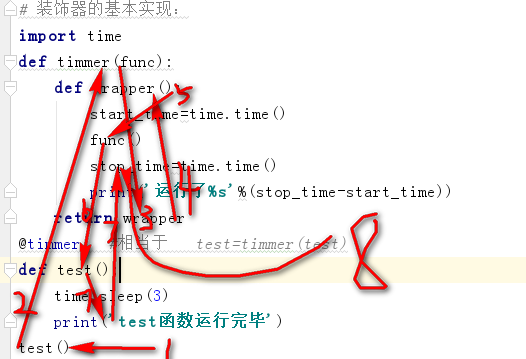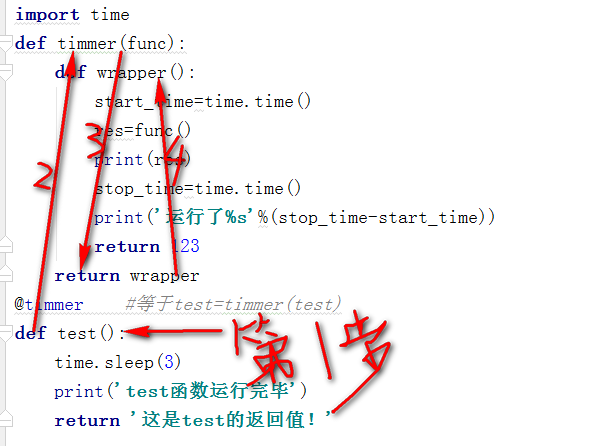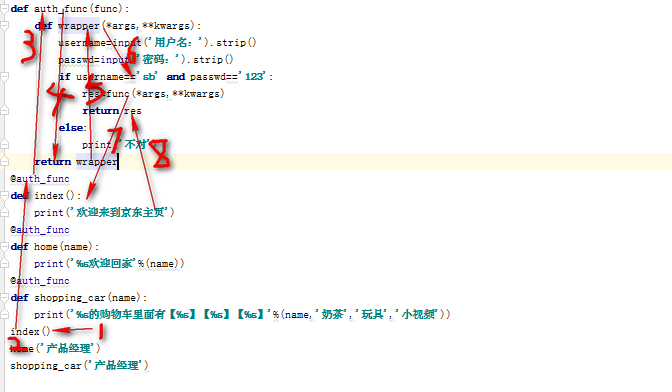一、装饰器:
1.装饰器的基本实现:


2.
# def cal(): # res=0 # for i in range(5,10): # res+=i # return res # print(cal()) # # 是从0加到4 # # import time # def cal(): # start_time=time.time() # res=0 # for i in range(10): # res+=i # stop_time=time.time() # print('这个函数的运行时间是%s'%(stop_time-start_time)) # return res # print(cal()) # import time # def timmer(func): # def wrapper(*args,**kwargs): # start_time=time.time() # res=func(*args,**kwargs) # stop_time=time.time() # print('函数运行的时间是%s'%(stop_time-start_time)) # return res # return wrapper # @timmer # def cal(): # res=0 # for i in range(10): # time.sleep(0.1) # res+=i # return res # print(cal()) # 高阶函数复习 # def foo(): # print('你好啊林师傅') # def test(func): # print(func) # test(foo()) # test(foo) # def foo(): # print('你好啊林师傅') # def test(func): # print(func) # func() # test(foo) # def foo(): # print('from the foo') # def test(func): # return func # print(test(foo)) # # # pp=test(foo) # # pp() # # foo=test(foo) # foo() # def father(name): # print('from father %s'%name) # def son(): # print('from the son') # print(locals()) # father('alex') # def foo(): # name='lijialun' # def pp(): # name='sjdk' # print(locals()) # return pp() # foo() # local()函数的作用:将局部变量显示出来,并且以字典的形式。 # 装饰器的基本实现: import time def timmer(func): def wrapper(): start_time=time.time() func() stop_time=time.time() print('运行了%s'%(stop_time-start_time)) return wrapper @timmer #相当于 test=timmer(test) def test(): time.sleep(3) print('test函数运行完毕') test() # # 加上返回值 # import time # def timmer(func): # def wrapper(): # start_time=time.time() # res=func() # print(res) # stop_time=time.time() # print('运行了%s'%(stop_time-start_time)) # return 123 # return wrapper # @timmer #等于test=timmer(test) # def test(): # time.sleep(3) # print('test函数运行完毕') # return '这是test的返回值!' # # res=test() # # print(res) # # # 这时,返回的是none!因为返回的不是test的return,而是timmer的return值,进而返回的是wrapper 的返回值。 # # 而wrapper没有返回值,因此是none # res=test() # print(res) # # 加上参数 # import time # def timmer(func): # def wrapper(*args,**kwargs): # start_time=time.time() # res=func(*args,**kwargs) # # stop_time=time.time() # print('运行了%s'%(stop_time-start_time)) # return res # return wrapper # @timmer #等于"test=timmer(test)" # def test(name,age): # time.sleep(1) # print('test函数运行完毕',name,age) # return '这是test的返回值!' # # @timmer #相当于“test1=timmer(test1)" # def test1(name,age,gender): # time.sleep(1) # print('test函数运行完,名字是%s,年龄是%s,性别%s' %(name,age,gender)) # return '这是test1的返回值!' # res=test('linhaifeng',18) # print(res) # pp=test1('wupeiqi',19,'男') # print(pp) # #这样就存在了参数不固定的问题 # #所以不能再wrapper中书写固定的参数——引入*,** # def test(*args,**kwargs): # print(args) # print(kwargs) # test(1,2) # #输出结果: # # (1, 2)————元组形式 # # {}————字典形式 # test(1,2,3,name=18) # #输出结果: # # (1, 2, 3) # # {'name': 18} # test(1,2,3,name=18,age=1999) # #输出结果: # # (1, 2, 3) # # {'age': 1999, 'name': 18} # # test(mee=wdw,1,2,3,name=18) # # SyntaxError: non-keyword arg after keyword arg # # 分析args,kwargs: # import time # def timmer(func): # def wrapper(*args,**kwargs): # start_time=time.time() # res=func(*args,**kwargs) # # stop_time=time.time() # print('运行了%s'%(stop_time-start_time)) # return res # return wrapper # @timmer #等于"test=timmer(test)" # def test(name,age): # time.sleep(1) # print('test函数运行完毕',name,age) # return '这是test的返回值!' # # @timmer #相当于“test1=timmer(test1)" # def test1(name,age,gender): # time.sleep(1) # print('test函数运行完,名字是%s,年龄是%s,性别%s' %(name,age,gender)) # return '这是test1的返回值!' # res=test('linhaifeng',18) # print(res) # pp=test1('wupeiqi',19,'男') # print(pp) # #这样就存在了参数不固定的问题 # #所以不能再wrapper中书写固定的参数——引入*,**
二、装饰器模拟session:
# user_dic={'username':None,'login':False} #定义了一个全局变量 # # def auth_func(func): # def wrapper(*args,**kwargs): # if user_dic['username'] and user_dic['login']: #字典的索引,即:None and False # res = func(*args, **kwargs) # return res # username=input('用户名:').strip() # passwd=input('密码:').strip() # if username=='sb' and passwd=='123': # user_dic['username']=username # user_dic['login']=True #这两步相当于直接把全局变量给改了,接下来就不用每次都输入用户名和密码了 # res=func(*args,**kwargs) # return res # else: # print('不对') # return wrapper # @auth_func # def index(): # print('欢迎来到京东主页') # @auth_func # def home(name): # print('%s欢迎回家'%(name)) # @auth_func # def shopping_car(name): # print('%s的购物车里面有【%s】【%s】【%s】'%(name,'奶茶','玩具','小视频')) # index() # home('产品经理') # shopping_car('产品经理') user_list=[ {'name':'alex','passwd':'123'}, {'name':'linhaifeng','passwd':'123'}, {'name':'wupeiqi','passwd':'123'}, {'name':'yuanhao','passwd':'123'} #用户信息列表 ] current_dic={'username':None,'login':False} #记录当前用户登录状态 def auth_func(func): def wrapper(*args,**kwargs): if current_dic['username'] and current_dic['login']: #字典的索引,即:None and False res = func(*args, **kwargs) return res username=input('用户名:').strip() passwd=input('密码:').strip() for user_dic in user_list: #user_dic是新的变量!! if username==user_dic['name'] and passwd==user_dic['passwd']: current_dic['username']=username current_dic['login']=True res = func(*args, **kwargs) return res else: #注意else 的位置! print('用户名不正确,或者密码错误') return wrapper @auth_func def index(): print('欢迎来到京东主页') @auth_func def home(name): print('%s欢迎回家'%(name)) @auth_func def shopping_car(name): print('%s的购物车里面有【%s】【%s】【%s】'%(name,'奶茶','玩具','小视频')) index() home('产品经理') shopping_car('产品经理')
三、生成器函数:
# p=(i for i in range(10)) # print(p) # print(next(p)) # print(next(p)) # print(next(p)) # print(next(p)) # print(next(p)) # def test(): # print('我要生孩子了') # print('我要生孩子了') # return '我' # res=test() # print((res))
四、解压序列:
# a,b,c=[1,2,3] # print(a) # print(b) # print(c) # a,b,c=(1,2,3,4) # print(a) # print(b) # print(c) # #报错! # # a,b,c='hel' # print(a) # print(b) # print(c) # # p=[10,3,2,4,6,2,23,53,2,2134] # #需求:只取第一个和最后一个 # a,*_,c=[10,3,2,4,6,2,23,53,2,2134] # print(a) # print(c) # a,*d,c=[10,3,2,4,6,2,23,53,2,2134] # print(d)
五、加验证:

def auth_func(func): def wrapper(*args,**kwargs): username=input('用户名:').strip() passwd=input('密码:').strip() if username=='sb' and passwd=='123': res=func(*args,**kwargs) return res else: print('不对') return wrapper @auth_func def index(): print('欢迎来到京东主页') @auth_func def home(name): print('%s欢迎回家'%(name)) @auth_func def shopping_car(name): print('%s的购物车里面有【%s】【%s】【%s】'%(name,'奶茶','玩具','小视频')) index() home('产品经理') shopping_car('产品经理')
六、生产者消费者模型:
# # # 复习一下enumerate()函数: # season=['spring','summer','fall','winter'] # print(enumerate(season)) # print(list(enumerate(season))) # # # 补充知识:触发生成器有三种方式:1,.__next__() 2.next() 3.send() # def test(): # print('开始啦') # yield 1 # print('第一次') # yield 2 # print('第三次') # yield 3 # t=test() # # # print(t.__next__()) # # # print(next(t)) # # # print(t.send(None)) # # # 以上三个方法的结果是一样的!!!!! # # print(t.send(None)) # t.send(None) # t.send(None) #相当于None赋值给了yield !!! # def test(): # print('开始啦') # yield # print('第一次') # yield 2 # print('第三次') # yield 3 # t=test() # print(t.__next__()) # t.send(None) # # # def test(): # print('开始啦') # first=yield # print('第一次',first) # yield 2 # print('第三次') # yield 3 # t=test() # print(t.__next__()) # # # print(t.__next__()) # # print(t.send(None)) # print(t.send('函数停留在first那个位置,我就是给first赋值的')) # 视频上的讲解: # def producer(): # ret=[] # for i in range(10000): # ret.append('包子%s'%i) # return ret # def consumer(name): # print('我是[%s],我准备开始吃包子了'%name) # while True: # baozi=yield # print('%s 很开心的把[%s]吃掉了' %(name,baozi)) # c1=consumer('wupeiqi') # c1.__next__() # c1.send('屎馅包子') # 自己的思考: # def consumer(name): # print('我是[%s],我准备开始吃包子了'%name) # # baozi=yield # print('%s 很开心的把[%s]吃掉了' %(name,baozi)) # yield 2 # c1=consumer('wupeiqi') # # # c1.send('屎馅包子') # print(c1.__next__()) # c1.send('屎馅包子') # 终结版: import time def consumer(name): print('我是%s,我准备开始吃包子了'%name) while True: baozi=yield time.sleep(1) print('%s很开心的把【%s】吃掉了'%(name,baozi)) def producuer(): c1=consumer('wupeiqi') c1.__next__() for i in range(10): time.sleep(1) c1.send('包子%s'%i) producuer()
七、函数闭包带参数装饰器:
user_list=[ {'name':'alex','passwd':'123'}, {'name':'linhaifeng','passwd':'123'}, {'name':'wupeiqi','passwd':'123'}, {'name':'yuanhao','passwd':'123'} #用户信息列表 ] current_dic={'username':None,'login':False} #记录当前用户登录状态 def auth(auth_type='filedb'): def auth_func(func): #这时不管auth_func有多少层,都能够接收auth_type这个参数。 def wrapper(*args,**kwargs): if auth_type=='filedb': #增加if判断auth_type if current_dic['username'] and current_dic['login']: #字典的索引,即:None and False res = func(*args, **kwargs) return res username=input('用户名:').strip() passwd=input('密码:').strip() for user_dic in user_list: #user_dic是新的变量!! if username==user_dic['name'] and passwd==user_dic['passwd']: current_dic['username']=username current_dic['login']=True res = func(*args, **kwargs) return res else: #注意else 的位置! print('用户名不正确,或者密码错误') elif auth_type=='ldap': print('鬼知道怎么玩,只是为了多一个选择而已') else: print('鬼知道你用的是什么类型') return wrapper return auth_func #返回auth_func相当于没有做任何改动,只是加了一层可选类型而已 。所以最终还是@auth_func @auth(auth_type='filedb') def index(): print('欢迎来到京东主页') @auth(auth_type='ldap') def home(name): print('%s欢迎回家'%(name)) @auth(auth_type='xxxxx') def shopping_car(name): print('%s的购物车里面有【%s】【%s】【%s】'%(name,'奶茶','玩具','小视频')) index() home('产品经理') shopping_car('产品经理')